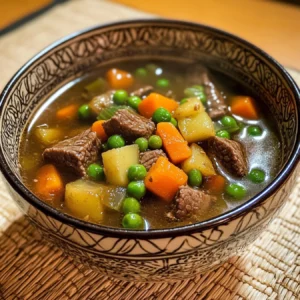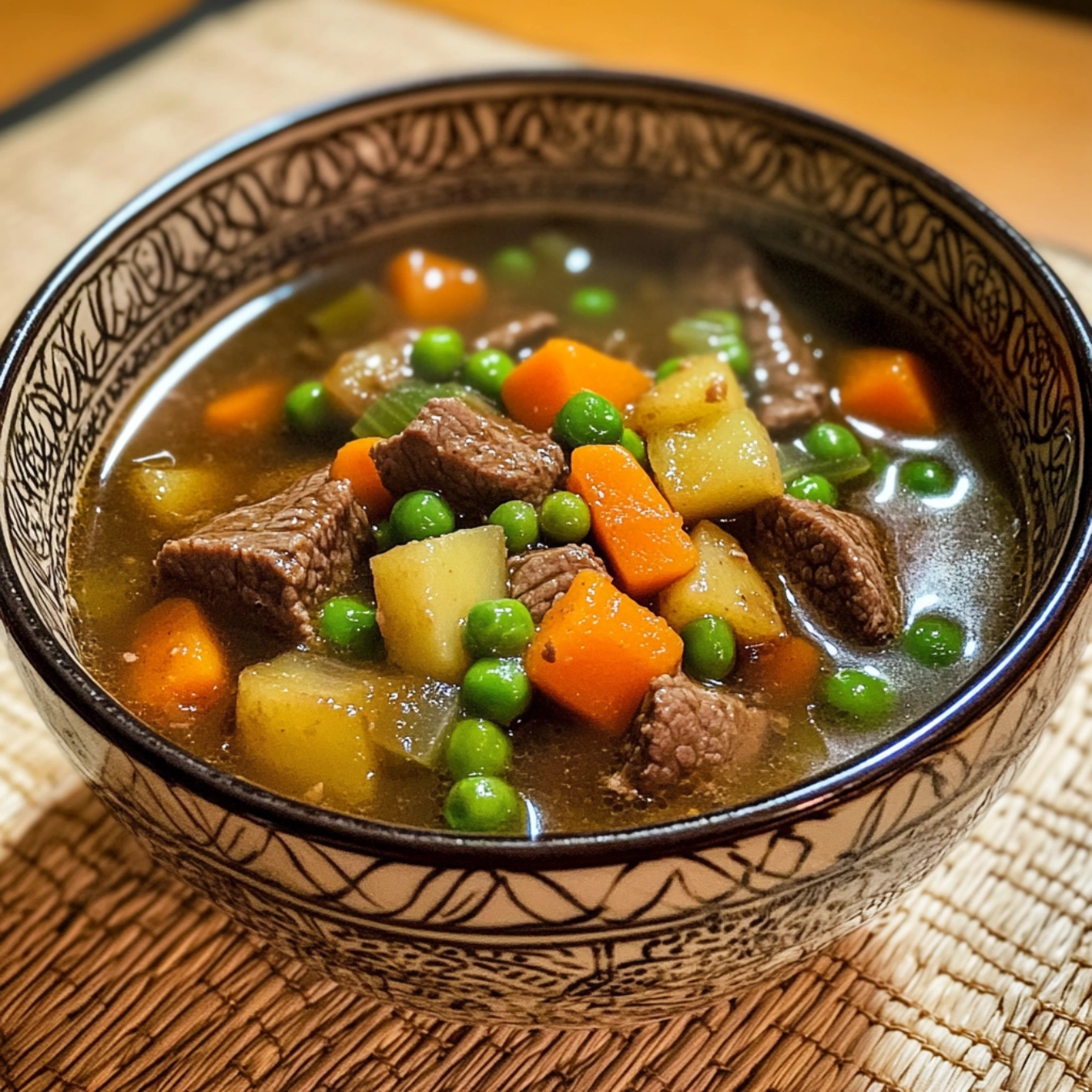Nothing compares to a warm, comforting bowl of Old-Fashioned Vegetable Beef Soup Recipe on a cold day! This classic homemade soup is filled with tender beef, hearty potatoes, and fresh vegetables, all simmered in a rich, flavorful broth. Perfect for family dinners, meal prep, or a cozy supper, this is the kind of stick-to-your-ribs dish that feels like a hug in a bowl.
Table of Contents
Why You Will Love This Recipe
✔ Deep, Rich Flavor : Browned beef and aromatic spices slow-simmered for the best taste.
✔ Loaded with Vegetables : A perfect mix of potatoes, green beans, corn, and carrots.
✔ Hearty & Protein-Packed : Keeps you full and satisfied.
✔ Perfect for Leftovers : Tastes even better the next day!
✔ Customizable : Add extra vegetables or swap ingredients to your preference.
Pair this hearty soup with baked beans recipe for a comforting and filling meal.
Ingredients
For the Soup:
- Beef Stew Meat (Round or Chuck, Cut into Bite-Sized Pieces) : Becomes fall-apart tender in the broth.
- Olive Oil : Enhances flavor and helps sear the beef.
- Diced Onion : Adds rich flavor to the soup base.
- Minced Garlic : Deepens the bold, savory taste.
- Carrots (Peeled & Sliced) : Provides natural sweetness and texture.
- Chopped Celery : A classic base ingredient for flavor.
- Diced Potatoes : Makes the soup hearty and filling.
- Green Beans (Trimmed & Chopped) : Adds a fresh, crisp bite.
- Corn Kernels (Fresh or Frozen) : Provides a touch of sweetness.
- Diced Tomatoes (With Juice) : Adds depth and tanginess.
- Beef Broth : Creates a rich, umami-packed base.
- Water (As Needed) : Helps control consistency.
- Worcestershire Sauce : Enhances the broth with a savory touch.
Herbs & Seasonings:
- Salt & Black Pepper : The essential base seasonings.
- Dried Thyme : Adds an earthy, aromatic note.
- Smoked Paprika : Infuses a subtle smoky warmth.
- Bay Leaves : Adds a delicate herbal depth to the broth.
- Fresh Parsley (For Garnish) : Brightens up the final dish.
👉 The complete ingredient list with measurements is in the recipe card below!

How to Make Old-Fashioned Vegetable Beef Soup
Step 1: Sear the Beef
- In a large pot over medium-high heat, warm olive oil.
- Add beef and season with salt and black pepper.
- Sear for 3-4 minutes on each side, until browned.
- Remove the beef from the pot and set it aside.
Step 2: Build the Soup Base
- In the same pot, sauté onion, garlic, carrots, and celery for 3-4 minutes, until softened.
- Stir in:
- Beef broth & water
- Diced tomatoes (with juice)
- Worcestershire sauce
- Thyme, smoked paprika, and bay leaf
- Return the seared beef to the pot and bring everything to a gentle simmer.
Step 3: Simmer the Soup
- Cover and simmer on low heat for 45 minutes, stirring occasionally.
- 💡 This allows the beef to tenderize and absorb the flavors!
Step 4: Add the Vegetables
- Stir in potatoes, green beans, and corn.
- Simmer for another 20-25 minutes, until the potatoes are fork-tender.
Step 5: Finish & Serve
- Remove the bay leaf and taste-test the soup. Adjust seasoning if needed.
- Serve warm, garnished with fresh parsley.
- Enjoy with crusty bread or cornbread for the perfect meal!

Pro Tips for the Perfect Vegetable Beef Soup
✔ Brown the Beef First : Searing locks in deep, rich flavors.
✔ Use Fresh or Frozen Vegetables : Fresh adds a little crunch, but frozen works just as well.
✔ Let It Simmer Low & Slow : The longer it simmers, the more flavorful the broth becomes.
✔ Want a Thicker Soup? Mash some potatoes into the broth to naturally thicken it.
✔ Make It a Stew : Reduce the broth and stir in a cornstarch slurry for a thicker consistency.
How to Serve
This classic vegetable beef soup pairs beautifully with:
- 🥖 Crusty Bread : Perfect for soaking up the rich broth.
- 🍞 Cornbread : Adds a touch of sweetness to balance the flavors.
- 🥗 Green Salad or Coleslaw : A fresh, light side dish.
- 🧄 Garlic Bread : Because beef and garlic are a match made in heaven!
Make-Ahead & Storage
Storing Leftovers
- Refrigerate in an airtight container for up to 4 days.
Reheating
- Stovetop: Heat on low, stirring occasionally.
- Microwave: Heat in 30-second intervals, stirring in between.
Freezing
- Store in portioned containers for up to 3 months.
- Thaw overnight in the fridge, then reheat before serving.
FAQs
1. Can I Use Ground Beef Instead of Stew Meat?
Yes! Brown 1 lb of ground beef, then follow the same instructions.
2. Can I Make This in a Slow Cooker?
Yes! Sear the beef first, then add everything to a slow cooker and cook on Low for 6-8 hours.
3. Can I Add Extra Vegetables?
Absolutely! Peas, bell peppers, or zucchini make great additions.
4. How Can I Make This Soup Extra Rich?
Use bone-in beef shank or short ribs, and add a splash of red wine for more depth of flavor.

Conclusion
Warm, hearty, and packed with bold flavors, this Old-Fashioned Vegetable Beef Soup is the ultimate comfort food classic. Whether you’re making it for family dinner, meal prep, or a cozy night in, this soup is guaranteed to satisfy and nourish.
❤ 😋 Ladle yourself a big bowl and enjoy this homemade favorite!

Old-Fashioned Vegetable Beef Soup
Equipment
- Large Pot
- Wooden spoon
- Knife
- Cutting Board
Ingredients
For the Soup
- 1 lb beef stew meat chuck or round, cut into bite-sized pieces
- 1 tbsp olive oil
- 1 small onion diced
- 3 cloves garlic minced
- 3 carrots peeled and sliced
- 2 stalks celery chopped
- 3 medium potatoes diced
- 1 cup green beans trimmed and chopped
- 1 cup corn kernels fresh or frozen
- 1 can diced tomatoes 14.5 oz, with juice
- 4 cups beef broth
- 1 cup water as needed
- 1 tsp Worcestershire sauce
- 1 tsp salt
- 1/2 tsp black pepper
- 1 tsp dried thyme
- 1/2 tsp smoked paprika
- 1 bay leaf
- 2 tbsp fresh parsley chopped (for garnish)
Instructions
- Heat olive oil in a large pot over medium-high heat. Add the beef and season with salt and pepper. Sear for 3-4 minutes per side until browned. Remove and set aside.
- In the same pot, sauté onion, garlic, carrots, and celery for 3-4 minutes until softened.
- Add the diced tomatoes, beef broth, water, Worcestershire sauce, thyme, smoked paprika, and bay leaf. Return the seared beef to the pot.
- Cover and let simmer over low heat for 45 minutes, stirring occasionally.
- Stir in potatoes, green beans, and corn. Simmer for another 20-25 minutes until potatoes are fork-tender.
- Remove the bay leaf. Adjust seasoning if needed. Garnish with fresh parsley and serve warm with crusty bread or cornbread.

